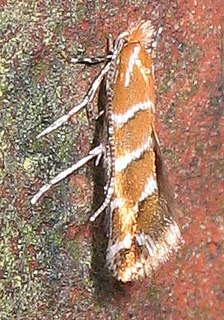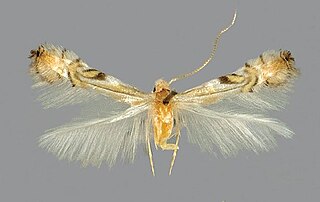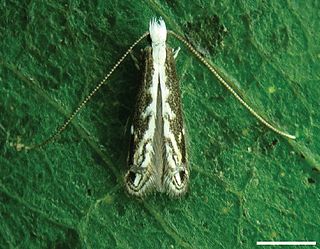
The horse-chestnut leaf miner is a leaf-mining moth of the family Gracillariidae. The horse-chestnut leaf miner was first observed in North Macedonia in 1984, and was described as a new species in 1986. Its larvae are leaf miners on the common horse-chestnut. The horse-chestnut leafminer was first collected and inadvertently pressed in herbarium sheets by the botanist Theodor von Heldreich in central Greece in 1879.

A leaf miner is any one of numerous species of insects in which the larval stage lives in, and eats, the leaf tissue of plants. The vast majority of leaf-mining insects are moths (Lepidoptera), sawflies, and flies (Diptera), though some beetles also exhibit this behavior.

Gracillariidae is an important family of insects in the order Lepidoptera and the principal family of leaf miners that includes several economic, horticultural or recently invasive pest species such as the horse-chestnut leaf miner, Cameraria ohridella.

Tebenna micalis, also known as the small thistle moth, is a species of moth in the family Choreutidae found worldwide. It was first described by the German Bohemian entomologist, Joseph Johann Mann in 1857.
Argyresthia canadensis, the Canadian arborvitae leafminer or cedar leafminer, is a moth of the family Yponomeutidae. It is found in North America.

Tischeria dodonea is a moth of the family Tischeriidae. It is found from Fennoscandia to the Pyrenees, Italy and Romania and from Ireland to Ukraine. There is a disjunct population in eastern Russia.

Hellula undalis, the cabbage webworm or Old World webworm, is a moth of the family Crambidae. It is a widespread species which is found from Europe across Asia to the Pacific. It was first described from Italy.
Leucoptera meyricki is a moth in the Lyonetiidae family that is found in Ivory Coast, Angola, Congo, East Africa, Ethiopia and Madagascar. It was also discovered in Kenya and Tanzania. It is considered one of the worst pest species on coffee.
Leucoptera coma is a moth in the family Lyonetiidae. It is found in Zaire and Uganda. It is considered a pest species on coffee.

Phyllocnistis is a genus of moths in the family Gracillariidae.
Gracillaria albicapitata is a moth of the family Gracillariidae. It is known from the islands of Hokkaidō and Honshū in Japan and the Russian Far East.
Eucalybites aureola is a moth of the family Gracillariidae. It is known from Hokkaidō island of Japan and the Kuril Islands.
Eucosmophora pouteriae is a moth of the family Gracillariidae. It is known from Costa Rica.
Eucosmophora manilkarae is a moth of the family Gracillariidae. It is known from Florida and Texas in the United States.
Eucosmophora pithecollobiae is a moth of the family Gracillariidae. It is known from Belize and from Florida in the United States.
Caloptilia alnivorella, the alder leafminer, is a moth of the family Gracillariidae. The species was first described by Vactor Tousey Chambers in 1875. It is known from the Russian Far East, Canada and the United States.

Phyllocnistis subpersea is a moth of the family Gracillariidae. It is found in the Dade and Monroe Counties of Florida. Mines of what appear to be this species have been found as far north as the Green Swamp in coastal South Carolina.
The elm casebearer moth is a moth of the family Coleophoridae. It is found in Canada, including Ontario.

Spinivalva is a genus of moths in the family Gracillariidae. It contains only one species, Spinivalva gaucha, which is found in Brazil.

Profenusa thomsoni, the amber-marked birch leaf miner, is a species of sawfly in the family Tenthredinidae. It is native to the Palearctic realm but has spread to North America. The larvae feed on the foliage of birch trees.










